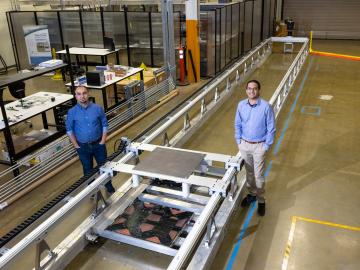
Filter News
Area of Research
- (-) Energy Science (29)
- (-) Fusion Energy (4)
- (-) Quantum information Science (2)
- Biology and Environment (21)
- Computational Biology (1)
- Computer Science (2)
- Fusion and Fission (18)
- Isotopes (17)
- Materials (32)
- Materials for Computing (6)
- National Security (10)
- Neutron Science (11)
- Nuclear Science and Technology (17)
- Supercomputing (50)
News Topics
- (-) Clean Water (3)
- (-) Computer Science (8)
- (-) Nanotechnology (3)
- (-) Nuclear Energy (6)
- (-) Transportation (17)
- 3-D Printing/Advanced Manufacturing (22)
- Advanced Reactors (2)
- Artificial Intelligence (2)
- Bioenergy (10)
- Biology (4)
- Biomedical (2)
- Biotechnology (1)
- Buildings (11)
- Chemical Sciences (3)
- Composites (2)
- Coronavirus (5)
- Cybersecurity (5)
- Energy Storage (20)
- Environment (18)
- Fossil Energy (1)
- Fusion (5)
- Grid (13)
- High-Performance Computing (2)
- Hydropower (1)
- Materials (6)
- Materials Science (4)
- Mathematics (1)
- Mercury (1)
- Microelectronics (1)
- Microscopy (3)
- National Security (1)
- Neutron Science (2)
- Partnerships (4)
- Polymers (1)
- Quantum Science (4)
- Security (3)
- Simulation (1)
- Space Exploration (1)
- Summit (2)
Media Contacts

Consumer buy-in is key to the future of a decarbonized transportation sector in which electric vehicles largely replace today’s conventionally fueled cars and trucks.

Oak Ridge National Laboratory expertise in fission and fusion has come together to form a new collaboration, the Fusion Energy Reactor Models Integrator, or FERMI

Through a consortium of Department of Energy national laboratories, ORNL scientists are applying their expertise to provide solutions that enable the commercialization of emission-free hydrogen fuel cell technology for heavy-duty

A team of researchers at Oak Ridge National Laboratory and Purdue University has taken an important step toward this goal by harnessing the frequency, or color, of light. Such capabilities could contribute to more practical and large-scale quantum networks exponentially more powerful and secure than the classical networks we have today.

Twenty-seven ORNL researchers Zoomed into 11 middle schools across Tennessee during the annual Engineers Week in February. East Tennessee schools throughout Oak Ridge and Roane, Sevier, Blount and Loudon counties participated, with three West Tennessee schools joining in.

As ORNL’s fuel properties technical lead for the U.S. Department of Energy’s Co-Optimization of Fuel and Engines, or Co-Optima, initiative, Jim Szybist has been on a quest for the past few years to identify the most significant indicators for predicting how a fuel will perform in engines designed for light-duty vehicles such as passenger cars and pickup trucks.

The Transformational Challenge Reactor, or TCR, a microreactor built using 3D printing and other new advanced technologies, could be operational by 2024.

Soteria Battery Innovation Group has exclusively licensed and optioned a technology developed by Oak Ridge National Laboratory designed to eliminate thermal runaway in lithium ion batteries due to mechanical damage.

Scientists at Oak Ridge National Laboratory used new techniques to create a composite that increases the electrical current capacity of copper wires, providing a new material that can be scaled for use in ultra-efficient, power-dense electric vehicle traction motors.

Scientists at ORNL and the University of Nebraska have developed an easier way to generate electrons for nanoscale imaging and sensing, providing a useful new tool for material science, bioimaging and fundamental quantum research.


